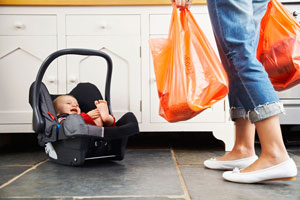What is a container baby?
So you are having a baby. Congratulations! Now what do you need? There are so many options of equipment for sleeping, playing and calming. You need a car seat. You want to have a carrier for hiking and a stroller for jogging. There is a jumper, a bouncer, a baby walker and a high chair. There are cradles that rock and vibrate. So many options but what is best for your baby? And how much equipment do you really need?
Not as much as you would think. You don’t want your child to become a “container baby,” whose development is being limited by prolonged use of equipment. Though the equipment or containers are convenient, they do take away time an infant could be spending developing skills needed for rolling, crawling, walking and eventually school work. Babies need the opportunity to look around, move, reach, turn, roll seek, and explore their new world without the limitations of a container.
A baby’s development is nurtured by nutrition, social and physical interaction, what they see and what they hear. Babies learn to move at first quite randomly and then more refined. A healthy baby learns to reach for a rattle, lift its head to look around a room and roll over to grab a toy. Before you know it your baby is sitting up, rocking on hands and knees or pulling to stand.
Development happens in just a moment. Progress depends on practice of basic skills. For example, a male infant is placed on the floor on his back. He is free to turn his head toward a sound or movement and then begins to turn farther to his side and eventually rolls over. Once on his tummy, the infant again hears or sees something of interest and learns to lift his head. The baby wants to see more and brings his arms under him to push up.
Babies are born with flexion — used to being in the fetal position. They like being swaddled and contained just like when they were in the womb. But they need to strengthen their necks and backs to develop extension to allow them to prepare for an upright world. They need to take weight through their arms during tummy time to support strengthening of their shoulders, arms and hands. This builds core strength and prepares them for reaching, placing objects and later for development of handwriting.
So what equipment is best for your child's development? Well, you need a place for the baby to sleep so you need a crib. You need a car seat, high chair and stroller for sure.
What about all the other options? Every option has a purpose but they all contain or envelop your baby, limiting their random movement that later develops into a refined functional movement, such as reaching to grab a toy. All the baby positioning options are good and some are essential but containers do limit the random movement that becomes refined into typical child development.
An example of the impact of containers is extended use of baby carriers or car seats. Of course you need to use a car seat for every trip in the car. Your baby loves the nice soft, cuddled feeling in the car seat and typically falls asleep with the movement of driving. You arrive at your destination and because your baby is sleeping you don't disturb them. Time goes by and you return home. Still a sleeping baby and you get some things done around the house before the baby awakens. Many hours have gone by since you left the house and although baby may have been changed or fed, this scenario if repeated day after day greatly limits time on the floor, whether it is on the belly, back or sitting up, that allows your child to practice and perfect how they are moving.
One other very important issue regarding excessive use of containers is the impact of head shape. There are a few reasons that babies develop misshapen heads. One reason is how they were positioned in the womb or due to the circumstances of delivery. Another is due to the presence of torticollis which limits head turning to one direction. There may be medical reasons as well such as with issues of reflux. But one reason that is preventable is this lack of random movement due to excessive or prolonged use of containers. Helmet therapy to help reshape a baby’s head can be avoided in these cases just by increasing time they spend on the floor.
To ensure your infant is getting enough time to explore and grow, limit time spent in containers to 30 minutes where possible. Spend time playing with your baby on the floor. And when containers are necessary, like with long car rides, schedule a play break or rest stop and give baby a break from the car seat.
